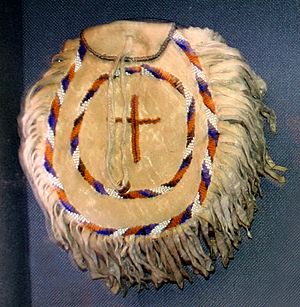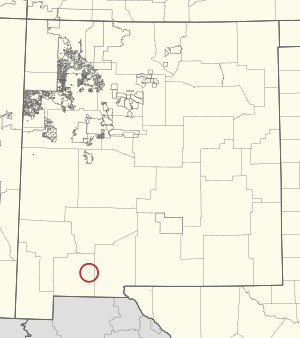Fort Sill Apache Tribe facts for kids
| Total population | |
|---|---|
| 650 | |
| Regions with significant populations | |
| Languages | |
| English Language, Apache language | |
| Religion | |
| Christianity, Native American Church, traditional tribal religion | |
| Related ethnic groups | |
| Kiowa-Apache, Jicarilla Apache, Lipan Apache, Mescalero Apache, Western Apache, Navajo |
The Fort Sill Apache Tribe is a Native American tribe. They are officially recognized by the United States government. This tribe is made up of Chiricahua Warm Springs Apache people living in Oklahoma.
Contents
How the Tribe is Governed
The main office for the Fort Sill Apache Tribe is in Apache, Oklahoma. To be a member of the tribe, you need to have at least 1⁄16 Apache heritage. This means one of your great-great-grandparents was Apache. About 650 people are members of the tribe.
The tribe keeps strong connections with other Chiricahua Apache people. Many of these relatives moved to the Mescalero Apache Reservation a long time ago.
The tribe elects a leader called the tribal chairperson. Lori Gooday Ware is the current chairperson. This job lasts for two years, just like the positions on the tribal council.
Tribal Lands
The Fort Sill Apache Tribe has special areas where their laws apply. These areas are in Caddo, Comanche, and Grady Counties in Oklahoma. These are not reservations, but places where the tribe has authority.
The tribe also has some land in Cochise County, Arizona. A private owner gave back four acres of sacred land to the tribe. This land is now held in trust for the tribe.
In 2011, the tribe won an important right. They could create a reservation in New Mexico. Now, they control about 30 acres of land near Deming, New Mexico.
Building the Tribe's Future
The Fort Sill Apache Tribe has several programs to help its members. They have their own housing program. They also run Fort Sill Apache Industries and the Fort Sill Apache Casino in Lawton. In 2008, the tribe's businesses added $10 million to the economy.
The tribe also works to protect the environment. In 2007, they teamed up with the U.S. Environmental Protection Agency (EPA). They started an office to stop illegal dumping and encourage recycling. They also train people to manage water systems and teach everyone about environmental issues.
A Look at History

The Fort Sill Apache Tribe comes from the Chiricahua Apache people. The Chiricahua were made up of four main groups:
- Chihende (also called Warm Springs Apache)
- Chukunende (also called Chiricahua proper)
- Nde’ndai (also called Sierra Madre Apaches)
- Bidánku (also called Mogollon Apaches)
The Apache people speak a language from the Athabaskan family. Many centuries ago, their ancestors traveled from the cold northern areas. They settled in the southwestern part of what is now the United States. The Chiricahua lived in southeastern Arizona and southwestern New Mexico. They also lived in northern Mexico. By the late 1800s, their lands covered about 15 million acres.
In 1886, the U.S. government took the Chiricahua people as prisoners of war. This happened during the Apache Wars. The government wanted to stop the Apache from resisting new settlements. About 400 tribal members were taken from their homes. They were sent to U.S. Army bases in Alabama and Florida. Some Apache warriors were held at Fort Pickens in Florida. Their special drawings, called ledger drawings, are now kept at the Smithsonian Institution.
Many Apache Scouts helped the U.S. Army. But even they were arrested and sent on the same train as Geronimo. These scouts came from different Apache groups. Some were even Apache chiefs.
In 1894, the U.S. Congress made a special rule. This allowed the Chiricahua to move to Indian Territory. They were the last Native American tribe to be moved to what is now Oklahoma. When they arrived at Fort Sill, they were promised land around the fort. But local non-Native people did not want the Apache to settle there. Many Apache wanted to go back to their old lands in the Southwest. The Mescalero Apache offered them land on their reservation.
About a third of the Chiricahua stayed in Indian Territory. They wanted the U.S. government to keep its promise. As a compromise, the government gave them land nearby. This land was on the Kiowa-Comanche-Apache Reservation. In 1914, 84 people were finally freed from prisoner status. They received land around Fletcher and Apache, Oklahoma.
The Fort Sill Apache faced many challenges in Oklahoma. The area was not doing well economically. But they found hope with the Oklahoma Indian Welfare Act of 1936. After much hard work, they were officially recognized as a tribe in 1976.
Mildred Cleghorn was the first elected chairperson in 1976. She was one of the last Chiricahua Apache born as a "prisoner of war." She was a teacher and made traditional dolls. She was seen as a cultural leader among the elders. She led the tribe until 1995. Her main goal was to keep Chiricahua history and culture alive.
Allan Houser was the first Fort Sill Apache child born free. He became a very famous Native American sculptor. His sons, Bob Haozous and Phillip Haozous, are also successful sculptors today. They are both members of the tribe.
Education
The Fort Sill Apache Indian Reservation is part of the Deming Public Schools district. This is the same school district as other areas in Luna County.
Famous Tribal Members
- Mildred Cleghorn (1910–1997), the first chairperson of the tribe, also a textile artist.
- Nancy Marie Mithlo, a professor, curator, and expert in visual anthropology.
- Bob Haozous (born 1943), a modern sculptor.
- Allan Houser (1914–1994), a famous sculptor and painter.
- Geronimo (1829–1909), a tribal leader before he was imprisoned.


